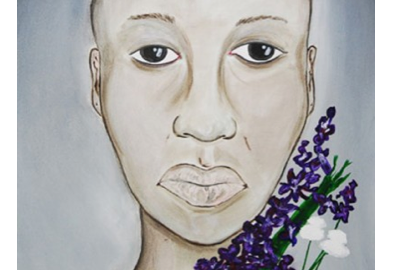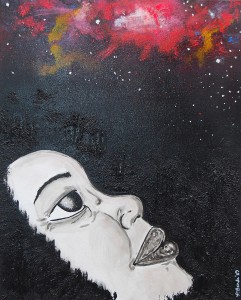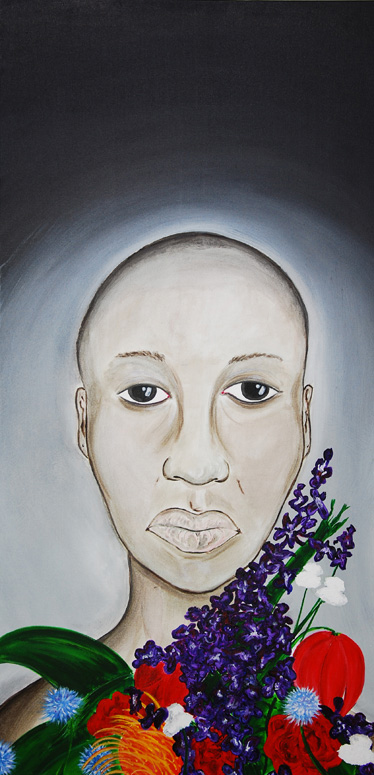
I have a mental cache of conversations exchanged between strangers-turned-friends regarding my artwork. The second or third question folks usually ask is, “Which school did you go to?” When I reply that I’m self-taught, a puzzled expression slowly takes over their face; then they mention their artistic niece, or the neighbor’s kid that just graduated from MICA, Howard, or Parsons.
Self-taught artists are usually defined by what we lack: a formal education from a well-known art institute resulting in a Bachelor of Fine Arts or Master of Fine Arts degree. The extent of my arts “education” consists of a Smithsonian mask-making workshop, a summertime drawing class, and an eight-week photography & film development course at Corcoran during my early teens. Since I discovered my passion for paint and canvas nine years ago, there are a few things I’ve learned about the differences between artists who are self-taught and those who are formally trained.
Finding your technique without direct influence from a professor or mentor is different. I never thought to reference instruction books, though I probably should have. I was clueless regarding sketching before painting, whether darker colors go on first, or what functions certain brushes provided. Sketching before painting reminds me of the saying “Measure twice, cut once”, which I apply to every other aspect of life, but I almost never sketch. Through mixing acrylics with water or cooking oil, I found a way to use less paint while learning, and eventually incorporated that technique into my regular painting regimen. Reusing and layering “dirty” water is how most of my work is achieved. I fell in love with how olive oil made colors richer and watered-down acrylics extended the drying time and created the illusion of watercolor. Though I learned everything the hard way, learning by trial and error has always been most comfortable for me. I believe that there is no right way or wrong way – just my way. I now listen more keenly to intuition.
After getting comfortable enough to consider publicizing my artwork, I discovered another daunting aspect of being a self-developed artist: networking. I struggled with questions that degreed artists already know the answer to. Which of the gazillion art orgs out there should I join? Do I need a website since some artists don’t have one? How do I get into shows and build my résumé? Thank goodness for Utrecht Art Supply’s bulletin board and Google… I started reaching out to folks who left business cards or flyers, which led to acceptance into a group exhibit. Interacting with other artists and art-lovers forced me to self-critique my paintings. If someone asked questions about my intentions or color choices, I had to find an answer and stand firmly beside it. This practice turned out to be a tremendous confidence builder.
That warm, fuzzy feeling of meeting new peers sparked a desire to submit to other shows, but I was soon rejected more times than not. Maybe I just didn’t know which shows were the best fit for my work. At times, I sensed a stigma attached to being self-taught. Like a trusted brand, a degree legitimizes an artist’s work in the eyes of prospective buyers, dealers, galleries, grant givers, proposal readers, arts publications, the list goes on. And call it paranoia, but when I submit work for juried shows beyond the DC-Baltimore area, I feel I get rejected because I lack proper training. It’s seems galleries are less likely to take a chance on someone like me. The living self-taught painters that galleries tend to admire – so-called outsider or folk artists – work in abstracts, are expressionists, or convey an obvious socio-political viewpoint through their work. My work doesn’t really fit into these categories. However, rejection serves as a jolt of I-Can-Show-You motivation. I’m excited to exhibit in Lust at ArtDC Gallery in Hyattsville through March 3rd and Soul Revival at The Meroe Art Gallery in Baltimore April 24th to July 31th.
The notion of being a self taught artist might be a question of semantics. Many of the degreed artists I’ve met have shared how art school stifled their creativity, and how they eventually had to discover their own process. Though the frustrations of being self-taught can be overwhelming, the journey of understanding myself through creation, and the friends I’ve made, are deeply rewarding, and exciting.
 Born in Florida and raised in Washington, DC since infancy, Prudence inherited the “creative gene” and started to draw at age four. Throughout childhood and adolescence, Prudence expressed several methods of creativity including writing, mask making, and photography & film development. She began painting consistently in 2001 and in April 2003 participated in the Smithsonian Early Enrichment Center’s 10th Annual Scholarship Fund benefit auction. Prudence donated “Girl Tantalus”, an original work of acrylic on canvas portraying the fabled origins of the word tantalize. She depicts people living throughout the African Diaspora, and beyond, by using color, texture, and introspection. Since acceptable images of human concepts such as love and beauty are perpetuated through art, literature, music, and the media, her pieces echo the attempt made by people of color to redefine and re-present those concepts in their terms. To learn more about her work, visit www.prubonds.com.
Born in Florida and raised in Washington, DC since infancy, Prudence inherited the “creative gene” and started to draw at age four. Throughout childhood and adolescence, Prudence expressed several methods of creativity including writing, mask making, and photography & film development. She began painting consistently in 2001 and in April 2003 participated in the Smithsonian Early Enrichment Center’s 10th Annual Scholarship Fund benefit auction. Prudence donated “Girl Tantalus”, an original work of acrylic on canvas portraying the fabled origins of the word tantalize. She depicts people living throughout the African Diaspora, and beyond, by using color, texture, and introspection. Since acceptable images of human concepts such as love and beauty are perpetuated through art, literature, music, and the media, her pieces echo the attempt made by people of color to redefine and re-present those concepts in their terms. To learn more about her work, visit www.prubonds.com.
